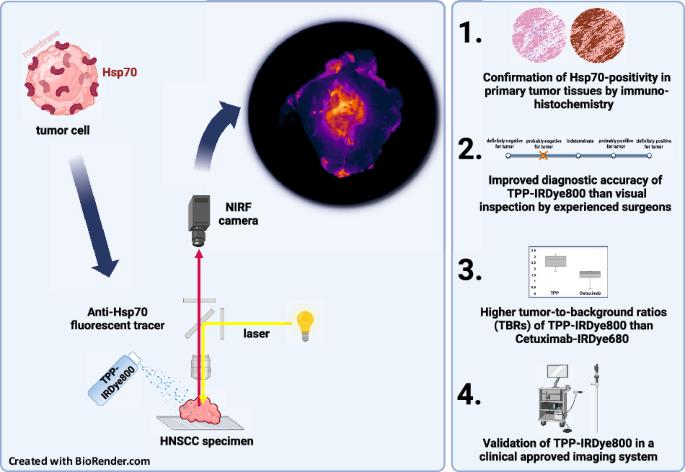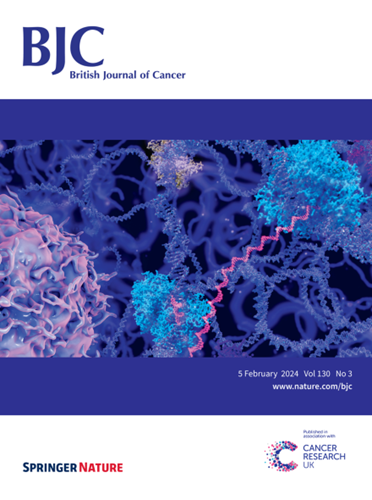利用多肽示踪剂 TPP-IRDye800 靶向肿瘤细胞膜结合 Hsp70,改进人类头颈癌的体内外荧光成像。
IF 6.4
1区 医学
Q1 ONCOLOGY
引用次数: 0
摘要
背景:HNSCC 手术的首要目标是完全切除肿瘤细胞并最大限度地保留正常组织。膜 Hsp70 靶向荧光标记肽 TPP-IRDye800 是一种很有前景的术中肿瘤实时可视化工具,可用于检测真正的肿瘤边缘、高级别发育不良的临界区和 LN 转移:方法:使用 FITC 结合物 mAb cmHsp70.1 和 TPP,通过流式细胞术和荧光显微镜测定 HNSCC 细胞系和原发性 HNSCC 的膜 Hsp70(mHsp70)表达。将 TPP-IRDye800 喷涂在经免疫组化证实的 HNSCC 和 LN 转移瘤的新鲜切除肿瘤材料上,进行肿瘤成像。使用 TPP-IRDye800 和识别表皮生长因子受体的西妥昔单抗-IRDye680 比较 TBR。TPP-IRDye800在原发性HNSCC上的TBR(2.56 ± 0.39)和AUC[0.98 CI, 0.95-1.00 vs. 0.91 CI, 0.85-0.97]显著高于西妥昔单抗-IRDye680(1.61 ± 0.39)(p = 0.0068),TPP-IRDye800能提供更好的肿瘤分界。荧光成像的 AUC 值高于外科医生的肉眼观察 [0.97 CI, 0.94-1.00 vs. 0.92 CI, 0.88-0.97] (p = 0.048)。使用 TPP-IRDye800 可以观察到 LN 转移。临床应用的 KARL-STORZ 成像系统确认了实时组织划分:结论:TPP-IRDye800是一种很有前景的HNSCC荧光成像探针。本文章由计算机程序翻译,如有差异,请以英文原文为准。

Improved ex vivo fluorescence imaging of human head and neck cancer using the peptide tracer TPP-IRDye800 targeting membrane-bound Hsp70 on tumor cells
The primary goal of surgery in HNSCC is the complete resection of tumor cells with maximum preservation of normal tissue. The membrane Hsp70-targeting fluorescence labelled peptide TPP-IRDye800 represents a promising tool for real-time intraoperative tumor visualization, enabling the detection of true tumor margins, critical isles of high-grade dysplasia and LN metastases. Membrane Hsp70 (mHsp70) expression on HNSCC cell lines and primary HNSCC was determined by flow cytometry and fluorescence microscopy using FITC-conjugated mAb cmHsp70.1 and TPP. TPP-IRDye800 was sprayed on freshly resected tumor material of immunohistochemically confirmed HNSCC and LN metastases for tumor imaging. TBRs were compared using TPP-IRDye800 and Cetuximab-IRDye680, recognizing EGFR. mHsp70 expressing HNSCC cells specifically bind and internalize TPP in vitro. The TBR (2.56 ± 0.39) and AUC [0.98 CI, 0.95–1.00 vs. 0.91 CI, 0.85–0.97] of TPP-IRDye800 on primary HNSCC was significantly higher than Cetuximab-IRDye680 (1.61 ± 0.39) (p = 0.0068) and TPP-IRDye800 provided a superior tumor delineation. Fluorescence imaging showed higher AUC values than a visual inspection by surgeons [0.97 CI, 0.94–1.00 vs. 0.92 CI, 0.88–0.97] (p = 0.048). LN metastases could be visualized using TPP-IRDye800. Real-time tissue delineation was confirmed using the clinically applied KARL-STORZ imaging system. TPP-IRDye800 is a promising fluorescence imaging probe for HNSCC.
求助全文
通过发布文献求助,成功后即可免费获取论文全文。
去求助
来源期刊

British Journal of Cancer
医学-肿瘤学
CiteScore
15.10
自引率
1.10%
发文量
383
审稿时长
6 months
期刊介绍:
The British Journal of Cancer is one of the most-cited general cancer journals, publishing significant advances in translational and clinical cancer research.It also publishes high-quality reviews and thought-provoking comment on all aspects of cancer prevention,diagnosis and treatment.
 求助内容:
求助内容: 应助结果提醒方式:
应助结果提醒方式:


